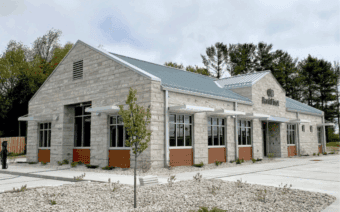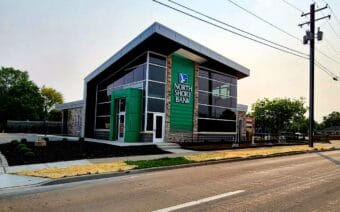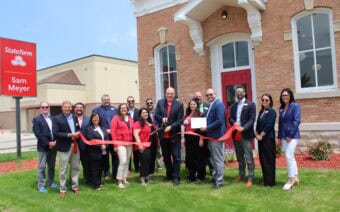
December 2, 2024
NORTHEAST WISCONSIN – Twentieth-century economist John Maynard Keynes once described economics as “a very dangerous science.”
Contemporary “post-Keynesian” economist Steve Keen has quipped economics is “too important to leave to the economists.”
In light of these remarks, Chief Economist of the National Federation of Independent Business (NFIB) Bill Dunkelberg finds himself assigned an unenviable task: attempting to economically summarize and collectively diagnose the country’s small businesses.
First, studies like Dunkelberg’s must account for a distinction between Wall Street and Main Street – metaphorical segments of American businesses faced with different, at times unrelatable goals, struggles and operations.
Even so, NFIB reports that Main Street/small businesses are still often unrelatable to given regions of the United States – including Northeast Wisconsin, as several regional experts have recently said.
If, as Dunkelberg said to Yahoo! Finance in September, “uncertainty is the enemy of economic progress,” how are Northeast Wisconsin business communities and Main Street programs able to make progress and encourage spending and hiring – faced with the uncertainty of national reports not aligning with local reality?
To help answer this question and provide a snapshot of the regional economy at present, a handful of leaders throughout Northeast Wisconsin share their thoughts on behalf of their respective organizations and municipalities.
- Barb LaMue, president/CEO of New North, Inc. (Northeast Wisconsin)
- Brian Johnson, president/CEO of On Broadway, Inc. (Green Bay)
- David Vander Bloomen, president/CEO of the De Pere Chamber of Commerce
- Jason Ring, director of Two Rivers Main Street
- Peter Thillman, chief economic development officer of Shawano County Economic Progress, Inc.
- Sadie Howell, president/CEO of Envision Greater Fond du Lac
Is NE Wisconsin economically exceptional?
These six local experts – citing a blend of statistics and anecdotal evidence – share a basic agreement: The region’s economy consistently performs at least as well as the rest of the U.S., if not better.
“Northeast Wisconsin’s economy often tracks similarly to national trends in some areas, such as overall growth patterns and the effects of economic downturns and demographics, especially in the Midwest,” LaMue said. “The region performs somewhat better than national averages in areas like manufacturing – especially in specialized sectors like paper products, machinery and food processing – agriculture and health care, where it has longstanding regional strengths.”
Though manufacturing and agriculture can be more susceptible to international trade fluctuations, which could affect our regional economy, LaMue said the diversity of the types of manufacturing and agricultural products produced in Northeast Wisconsin helps to mitigate the fluctuations.
Howell, likewise, said a diverse industrial base of manufacturers is a strength of the region – one she locally credits to Fond du Lac County’s ability to “bounce back from recessions, or even many recessions, faster than the State of Wisconsin and definitely the nation” dating back to the 1980s.
“When one (industry) is up, one might be down,” she said. “We also have different industries than just manufacturing. We have health care, financial services, education, government – so this mix has become really stable.”
In Green Bay, Johnson said he has witnessed similar insulation from national issues.
“(National) trends are important to monitor, but in my time working in economic development, Wisconsin has done an above-average job with bucking those downward trends and has buffered ourselves from the volatility that often happens during economic cycles,” he said. “It doesn’t mean we’re without pain points, but our deviation seems to be more resilient than other parts of the country.”

Perhaps surprisingly, the weather in Northeast Wisconsin, LaMue and Howell said, is another advantage of the area.
“We don’t experience significant disruptive weather patterns as experienced elsewhere in the country,” LaMue said.
Howell said Fond du Lac is not often subject to some of the volatile swings that other states experience, “or even (other) parts of our state.”
“Northern Wisconsin is a great example – one horrible winter and businesses shut down because almost 100% of their revenue is dependent on tourism,” she said.
Thillman, whose economic development experience has covered not only Shawano but Green Bay and the Fox Cities, said national winds of economic change do affect local business communities, albeit with some postponement.
“Historically, when we look at national trends, the State of Wisconsin tends to (experience) a delay in that we’d be late going into recessions and coming out, compared to the national economy – because of our heavy manufacturing basis,” he said. “Locally, we have a lot (of businesses) that are suppliers to OEMs, and depending on the OEM, we’re seeing some that are (supplying) high-price-tag pieces of equipment (experience) a little bit of a slowdown, just because of the interest rate environment and the (presidential) election. Hopefully, now that we’re beyond the election, there’ll be a little bit more clarity and capital decisions can be made, so we might see a bit of a change in that also.”
Though some national and international issues will unavoidably work their way to Northeast Wisconsin, Johnson said the region’s fiscally conservative tendencies lead to a more stable foundation for businesses, in turn instilling a stronger ability to absorb impacts from broader factors.
“The Midwest is not particularly well known for taking huge risks,” he said. “Often, we’re trend followers, which helps mitigate our risk exposure in business decision-making which directly impacts our workforce. (Regional) startups have sound ideas that are well-tested, and when those businesses secure venture or angel investments, they’re good bets because of the limited amount of capital available for deployment. Essentially, the best ideas rise to the top, and the steady, established businesses have a strong ability to weather downturns in an economically viable way.”
Johnson and Ring both said another stabilizing characteristic of the region is its people.
“Wisconsin is incredibly fortunate to have a well-trained workforce, complemented with a good work ethic and strength in our soft skills,” Johnson said.
“We have a lot of people willing to work, and I think we have a pretty skilled and educated workforce,” Ring said. “We have several opportunities for education and training in Northeast Wisconsin.”
Echoing Ring’s comment, LaMue said the state and region also “tend to have higher labor participation rates and lower unemployment.”
The U.S. Bureau of Labor Statistics (BLS) reported for 2023 a national labor force participation rate of 62.6% and an unemployment rate of 3.6%.
For Wisconsin in 2023, the BLS reported a labor force participation rate of 65.8%, with a statewide unemployment rate of 3%.
Per New North, in 2023, Northeast Wisconsin’s labor force participation rate was 64%, with an unemployment rate of 2%.
Relevant regional reports
In regard to the relative resiliency of Northeast Wisconsin’s economy, the local experts said they do glean some value – ranging from curiosity to bases of comparison – from national reports like those of NFIB.
Though they said the more localized reports are far more representative.
“The labor force and the skill sets demanded in Northeast Wisconsin can differ from those in larger urban areas,” LaMue said. “As national reports might focus more on high-tech sectors or urban economic growth, they don’t always capture the particular strengths of a manufacturing-heavy, rural-urban mixed economy like Northeast Wisconsin’s.”
She also said large national economic shifts, “such as the rise of the tech sector or changes in global supply chains,” might impact larger urban areas to a higher degree – which affects the relevance of national trends.
Johnson said though jobs reports and other national economic indicators are a good tool to help identify trends, especially in larger industries, he’s “never found a better substitute than talking to business owners and asking them directly how they’re doing.”
Vander Bloomen said he finds it more valuable to “try and lean on reports from sources close to the subject matter.”
“New North, Inc. has been fantastic with their processing and sharing of relevant content that truly applies here locally,” Vander Bloomen said. “Discussing these aspects with our local and state elected officials has also been beneficial for me in advocating to our (De Pere Chamber of Commerce) member businesses.”
Of the experts interviewed, numerous said New North is a particularly valuable resource for regional economic data, along with Progress Lakeshore, Inc., Shawano County Economic Progress, Inc., Wisconsin Manufacturers & Commerce (WMC), WisConomy and independent business, retention and expansion (BRE) programs.

Beyond this anecdotal credibility, earlier this year, New North was named an Accredited Economic Development Organization by the International Economic Development Council (IEDC) – making it one of only 83 organizations across the country to earn the accreditation, and the only one in Wisconsin.
LaMue said New North’s online Intel Tracker is informed by a variety of data sources, including:
- The Wisconsin Department of Revenue
- The Wisconsin Department of Workforce Development (DWD) “for state-level and local employment data.”
- The U.S. Bureau of Economic Analysis (BEA) “for more granular economic statistics at the county level.”
- The Center for Rural Entrepreneurship “for insights into challenges and opportunities specific to rural regions within Northeast Wisconsin.”
- The Federal Reserve Bank of Chicago for “analysis on our local economic conditions that may differ from national trends.”
“We also include economic roundtable conversations with our board of directors who represent various industry segments and communities across our region with national and international perspectives,” she said.
The group said other less local resources they utilize include Federal Reserve Economic Data (FRED) presented by the Federal Reserve Bank of St. Louis, the U.S. Census Bureau, data subscription service Lightcast, economic software such as IMPLAN and Esri and in some cases, even ChatGPT.
With such a variety at their disposal, the sources said the abundance of data creates its own challenge.
Appreciating this challenge, Johnson said “national and local economies are so complex, I think it’s impossible to identify one indicator that tells the full story.
“Even if you could narrow that list down to a half dozen items, such as interest rates, GDP, CPI, PPI, unemployment, energy costs, etc., how those items interact with one another creates an unlimited number of outcomes,” he said. “Additionally, the impact each of those items has on one region to the next can be vastly different. The importance of federal, state and local governments working together cannot be overstated to ensure incentives are delivered to move outcomes in a targeted way because one size does not fit all when it comes to economic development.”
Also, since economic data is often aggregated at the state or national level, LaMue said it can be harder to capture the nuances of small, rural communities.
“The cities like Green Bay, Appleton or Sheboygan might have more in common with national trends, while rural areas could have unique economic dynamics that differ significantly,” she said. “Additionally, economic data lags behind real-time shifts, meaning that regional recovery or growth might be underreported for months.”
Vander Bloomen said another interpretation issue – influenced by an influx of virtual connections from the conditions of COVID-19 – is the difficulty of assessing the regional economy “because so many companies now have a larger reach.”
“If I’m a (Northeast Wisconsin) business owner doing fantastic with businesses in South Dakota, but I’m struggling here locally, my numbers will show I’m doing well,” he said. “When in reality, my revenue and interest is not from around here. I have spoken to a couple of our chamber members in recent months who have shifted their focus on new business efforts out of the area because elsewhere may be doing ‘better.’”
Thillman said for him, it’s a matter of deciding which data is most important.
“I don’t really focus on the unemployment rate… I focus more on the size of the labor force and the number of people working, because you can have a low unemployment rate and shrinking labor force (in a) really tight, constrained labor market,” he said. “But our labor market has been increasing in the last four years, which is important because that sustains a lot of our growth.”
Thillman said he takes particular interest in workforce migration patterns, which for Shawano County have revealed 40-50% of its labor market leaves the county for work daily.
He said focusing solely on Shawano County’s 2% unemployment rate rather than its “labor force that’s just underutilized or misappropriated” might lead a business to decide against expanding operations there, rather than going forth with an expansion and attempting to recruit those who’d otherwise commute.
As Thillman said his position requires him to be something of a salesman on behalf of Shawano County, he adopts a “trust – but verify” approach to whichever data set he’s examining, especially when studying sentiment reports from NFIB or WMC.
“You can have some proximity bias and some recency bias on those, too,” he said. “I mean, it’s nice to see national trends, but I think it’s always the local stuff that really does the trick. So even from a ‘sales’ perspective… those global trends, exchange rates – that kind of stuff, I have no control over. I can just tell the story here.”
Though these experts largely said they agreed on the greater efficacy of regional reports, none definitively said national reports provide no value.
Vander Bloomen said in talking with members of the De Pere Chamber of Commerce, most indicate NFIB reports track fairly accurately with their businesses – depending on the industry.
“For example, I have found that the (regional) marketing industry usually reflects the national reports more accurately than, say, the construction industry,” he said. “I think when it comes to spending money, based on a negative report, the decision has to be made of whether what they’re purchasing is a need or a want. Many companies view marketing as a luxury and something they can do themselves to save money. They cannot build their addition themselves, typically.”
Howell also said certain industries need to account for more than regional perspectives.
“National trends are important, specifically with things like supply chain,” she said. “A lot of (those businesses) are all buying steel, so when trends in the national or international steel industry change, that definitely affects us locally. Other national trends, like the decline in kids going into healthcare (careers) – that definitely affects us. Even though it’s the national trend, that trickles down here to (asking) how are we getting our high schoolers prepared to consider a healthcare career right now? But then there are a lot of trends that don’t apply to us… still, it’s good to know what’s happening. When (national trends) do affect us, it’s good to know, and then when they don’t affect us, it’s just good information to have.”
Optimism – with asterisks
Based on a complementary variety of industries, talents and data sets, the regional experts rated Northeast Wisconsin’s economic outlook from strong to positive to somewhat positive.
“I think that Two Rivers’ economy, and that of Northeast Wisconsin, is in an okay place,” Ring said. “Positives… are companies in manufacturing are hiring, and there are jobs in other sectors as well. I get my optimism from seeing the new businesses getting started, properties renovated and new properties built in our downtown. There has been a lot of momentum over the past two years, with a lot of dollars being spent on building new and renovating older properties.”
Johnson said he’s also optimistic “from being able to work with businesses on a micro level – and nothing beats a face-to-face conversation.”
“Employment is strong, and anecdotally, I think consumer confidence and support for small businesses remains vigorous,” he said. “This is important because two-thirds of every dollar spent with a local small business stays in the local community. I find this to be an important consideration when evaluating local economic health.”
LaMue said the economy of Northeast Wisconsin is currently “experiencing a period of moderate growth, supported by key sectors like manufacturing, health care and logistics” – with continually steady growth expected due to improvements in the region’s industrial base and strong transportation infrastructure.

She also said Northeast Wisconsin is attractive to businesses and individuals alike due to its proximity to major Midwest markets and its relatively low cost of living – “19% below the national average and 9% below the state average.”
Other positive aspects, LaMue said, include:
- A relatively strong manufacturing base becoming increasingly resilient, as regional companies embrace automation and technological advancements
- A tech sector beginning to grow, citing support from the NEW Digital Alliance, incubators, accelerators, university and college partnerships, local partner programs and development, such as TitletownTech
- Efforts to improve workforce development through educational partnerships – such as the Northeast Wisconsin Educational Resource Alliance (NEWERA) – and training programs are helping to address local skill gaps and attract younger talent
- The aforementioned low unemployment rate
- Stable housing markets in urban areas
- Continued strengths in key industries
Though the six experts agreed on a general sense of optimism, they said they predict the region’s progress will be hindered for different reasons.
Howell said she sees an opportunity to attract larger projects by focusing on growing the region’s industrial park sector – yet she considers statewide collaboration and energy policies as limitations.
“We can only grow as fast as we have energy – and we are very lucky in having water and land as available resources – but what’s going to hold us back from a more aggressive form of growth is not having the amount of megawatts that we need to run large projects, like another Microsoft Data Center,” she said. “We, as a state, have to come together to really figure out how we are going to invest and where, and grow our electrical infrastructure.”
For Johnson, he said the challenges start with maintaining a highly skilled workforce.
“We’ve seen small businesses struggle in this area as employees have left the retail and hospitality sectors for wages and benefits that are more robust in the manufacturing sector,” he said. “It’s great that we have an economy that’s near full employment, but it has negative side effects that are hard to correct without impacting consumer prices.”
Thillman said though Northeast Wisconsin isn’t as challenged by the labor market as other regions, the issues are still “a given,” particularly in some industries.
“For the last probably 10, 15 years, (the primary challenge has) been the labor market, and that’s what has really been driving business decisions to a large extent – if there’s an available labor force,” he said. “There are certain positions that are just impossible or very difficult to fill and hold, and unfortunately, they happen to be some of the most critical jobs that you have in your community, like your daycare workers, your CNAs in elder facilities. They’re competing with Kwik Trip(’s wages and benefits) for employees. That’s where we’re at… I would say nationally that is the case. In any of those positions, if you’re going to pay competitively, it’s (going to lead to) unaffordable service. It’s a very delicate balancing act.”
Balancing staffing in retail and hospitality, Johnson said, is also necessary for supporting a vibrant downtown.
“Our professional industries and office-based businesses can fluctuate with staffing, which impacts the number of consumers patronizing our shops and restaurants,” he said. “This is why remote work has been detrimental to downtowns across the country. Fortunately, we’ve been able to backfill some of that lost demand with residential density that helps fill the gaps of consumer-driven activity with our small businesses.”
LaMue said workforce shortages – partially due to an aging population and partially because of hindering immigration laws – are holding back more robust growth.
“Without an influx of young, diverse talent, the region risks stagnation in emerging industries,” she said. “New North has significantly increased our marketing and recruitment. The region has experienced an average of 5,000 positive net migration to Northeast Wisconsin each of the last three years.”
Better access to necessary capital, Johnson and LaMue said, is another need for the region’s small businesses, startups and tech-driven industries.
“While progress is being made, Northeast Wisconsin still remains relatively dependent on manufacturing,” LaMue said. “More diversification – particularly in tech and renewable energy – is needed to buffer against economic downturns that affect traditional industries.”
She said smaller businesses and startups may face challenges accessing the capital they need for expansion, “which could limit innovation and economic development potential.”
“(Organizations), such as the NEW Launch Alliance, TitletownTech and others, delivered at local levels have been established to help address this issue,” LaMue said. “Oftentimes it is not a lack of available capital, but a need to help the founders get prepared to take on new debt and equity. Creating a favorable economic climate with access to capital, innovation and entrepreneurial support is key to attracting companies that could provide higher-wage jobs and a better standard of living for workers.”
Ring said though he appreciates the strength of manufacturing in Northeast Wisconsin, he would also like to see more growth in the area’s tech industries.
He said the primary limitations he hears about from Two Rivers small businesses of all industries are inflation and interest rates.

Childcare access is another community concern, Ring said – one that’s “been identified as a need, and our local EDC (economic development corporation), technical college and other partners are working to address this.”
Housing, he and Thillman both said, represents perhaps the greatest crisis facing Northeast Wisconsin’s economy, now and foreseeably.
“Housing is an area that we need more growth in, and higher interest rates and higher construction costs have stalled some larger housing complex projects, one of which is in our downtown and another adjacent to the downtown,” Ring said. “I hope as rates go down, costs might also, and we can get one or more projects going. This would be a boost to help companies looking for more workers.”
Thillman said not only do they need to keep the people that are leaving home to work within the market, “but we need to increase the net population growth of our region… and that’s been constrained by housing.”
“Everybody talks about affordable housing in rural America – it’s housing, period (that’s needed),” he said. “We need housing for executives, for doctors, for entry-level workers – from low-income to high-income.”
The seeds for the coming housing crisis, Thillman said, were sewn earlier this century.
“If you think about the 2008 recession, that wiped out all of our little home builders – wiped them all out,” he said. “So when the housing market came back, there’s no one here. There are no builders left. And labor is expensive, and materials got expensive. I never thought this would be the day that starter homes are $450,000 in Shawano.”
The big picture
In attempting to size up the economy of Northeast Wisconsin and forecast its future, Thillman said “there are a lot of things to diagnose – I just wish I had some prescriptions to fix it.”
“There are a lot of moving parts to get the economy moving, but I think we’re in a pretty healthy environment right now,” he said. “We’re not feeling the labor pains that we were feeling maybe four years ago once the wages caught up to the Valley, but it also put some pain on our existing businesses that had to keep up.”
Vander Bloomen said his approach is to focus on the people in his community more than any economic report.
“As everyone hears me say, ‘We do business differently in the De Pere area,’” he said. “I think what makes us special is that most companies put relationships first, and that goes so much deeper and further than transactions. So even when times are tough, people do what they can to stay loyal to help support each other – especially on a small business level. We also strive to be the Chamber of support and education, meaning that even in tough times, we can still learn something to help our business growth. So we really try and focus our efforts on those aspects, rather than the fear that can come with economic reports. We still discuss them, but we try and look at the big picture over the day-to-day (reports) when we’re having these conversations.”
LaMue said economic assessments should be closely tied to community engagement, local initiatives and workforce development efforts to ensure strategies align with the strengths and challenges unique to this area.
New North’s efforts to collaborate with local partners to address workforce development, she said, help to ensure there are the right skillsets and infrastructure available for new businesses and industries.
“(Northeast Wisconsin)’s economic development strategy focuses on making the region more competitive, particularly in sectors like advanced manufacturing, health tech and IT,” LaMue said. “The region’s economic future depends on its ability to continue to adapt, innovate and attract both business investment and talent.”
The area’s collective character, Johnson said, inspires his confidence.
“I’m always bullish on Wisconsin because we’ve had a long track record of distancing ourselves from economic headwinds that have negatively impacted other regions throughout the country,” Johnson said. “We don’t get in over our heads and we work well together to lift up our neighbors. Culturally, we’re built differently, and I like that about Northeast Wisconsin. It’s why so many people across the country admire the work ethic of Wisconsinites, and we should embrace it as one of our greatest qualities.”
 More than just clean laundry, it’s a way of giving back
More than just clean laundry, it’s a way of giving back Altoona continues to make history as U.S. birthplace of Crokicurl
Altoona continues to make history as U.S. birthplace of Crokicurl








